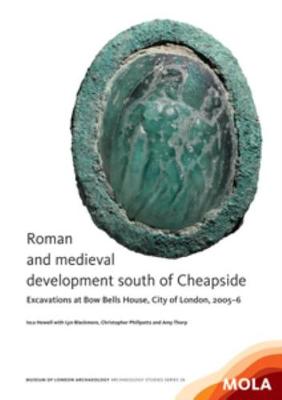MoLAS Archaeology Studies
3 primary works
Book 18
Excavations at 2-4 Old Church Street revealed prehistoric activity, a Roman rural settlement, and medieval gardens and domestic occupation associated with a medieval manor house, although most of the evidence for settlement related to the post-medieval period, when Chelsea changed from a village to a riverside resort and finally a suburb. A churchyard occupied the southern half of the site; here were recovered the skeletons of 290 parishioners buried between c.1700 and the mid 19th century, including two members of the Hand family who ran the Chelsea Bun House. The report considers various aspects of the cemetery, including its layout, and analysis of 198 skeletons provides demographic data for comparison with other London cemeteries and information on the health of this community.
Book 26
Roman and medieval development south of Cheapside
by Isca Howell, Lyn Blackmore, Christopher Phillpotts, and Amy Thorp
Published 30 June 2013
Excavations on the south side of Cheapside found evidence for Roman timber buildings and pits dating to the later 1st and 2nd centuries AD, and a masonry building constructed after c AD 125. The main west–east road through Londinium lay immediately north of the site. Evidence for later Roman occupation was limited by modern truncation.
No medieval ground surfaces survive, but the site was reoccupied from the 10th century with at least one substantial building existing by the 13th century. Pit and well groups include late 13th- or early 14th-century vessels associated with the wine trade and early 14th-century kitchenware.
No medieval ground surfaces survive, but the site was reoccupied from the 10th century with at least one substantial building existing by the 13th century. Pit and well groups include late 13th- or early 14th-century vessels associated with the wine trade and early 14th-century kitchenware.
Book 29
Roman roadside settlement and rural landscape at Brentford
by Robert Cowie, Amy Thorp, and Angela Wardle
Published 30 September 2013
Excavations in Syon Park, Brentford, have made a substantial contribution to our knowledge of this Roman rural settlement on the London–Silchester road, by a ford across the Thames. The site yielded a well-dated sequence – from the mid 1st to early 5th century AD – including occupation deposits and two 2nd-century timber buildings destroyed by fire, as well as details of the main road and adjacent field system. These and a large assemblage of finds, including a surgical instrument and a roundel depicting the Medusa, provide a rare glimpse of life in the countryside in the hinterland of Londinium. A detailed overview of Roman Brentford (the first to be published since 1978) is included.


